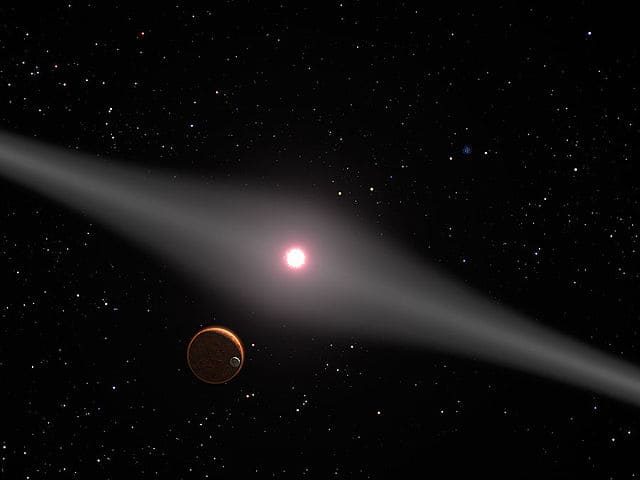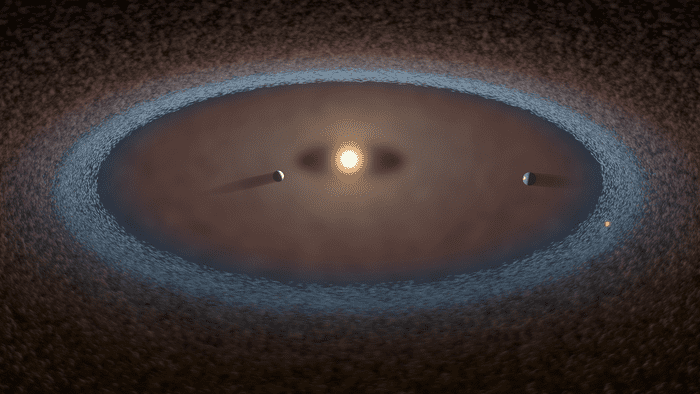
Super-Earths can be deeply fascinating. They are the most numerous type of planets in the galaxy, and stars can often host multiple ones. However, there isn’t a lot known about how they actually form. Now researchers could have discovered a scenario that could explain not only their origin, but how all rocky planets and moons form as well.
The study, published in the journal Nature Astronomy, could also explain why super-Earths within a single planetary system often appear eerily similar in size as if each system could only produce one type of planet.
“As our observations of exoplanets have grown over the past decade, it has become clear that the standard theory of planet formation needs to be revised, starting with the fundamentals,” said California Institute of Technology (CalTech) professor of planetary science Konstantin Batygin who collaborated with Alessandro Morbidelli of the Observatoire de la Côte d’Azur in France on the new concept. “We need a theory that can simultaneously explain the formation of the terrestrial planets in our solar system as well as the origins of self-similar systems of super-Earths, many of which appear rocky in composition.”
Like Earth but super
In the roughly 30 years since astronomers first began detecting exoplanets orbiting distant stars, scientists have discovered numerous bizarre new worlds unlike any in our solar system. These include super-Earths, which are rocky planets with up to 10 times the mass of Earth. Some super-Earths have hydrogen and helium atmospheres, giving them the appearance of gas giants at first glance.
Planetary systems begin their lives as large, rotating disks of gas and dust that consolidate over a few million years. Solid material slowly coalesces into asteroids, comets, planets and moons while the majority of the gas accretes to the central star of the system.
There are two distinct types of planets in our solar system: the inner, smaller, rocky planets closest to the Sun, and the outer, larger, water- and hydrogen-rich gas giants further out. In a 2021 study published in Nature Astronomy, this dichotomy led Morbidelli, Batygin and colleagues to propose that planet formation in our solar system occurred in two distinct rings of the protoplanetary disk: an inner one where the small rocky planets formed and an outer one for the more massive icy worlds (two of which, Jupiter and Saturn, later grew into gas giants).
Much remains unknown concerning the underlying causes of the differences between super-Earths and the terrestrial planets of the solar system — Earth, Mercury, Venus and Mars. Super-Earths are typically much larger than the Solar System’s terrestrial planets, approaching the diameters of ice giants such as Uranus and Neptune.
Moreover, stars frequently host multiple super-Earths, and those revolving around the same star are often similar in size, mass and orbital separation.
“Within a single planetary system, super-Earths are like ‘peas in a pod,'” said Andrew Howard, a professor of astronomy at Caltech who was not involved in the new study. “You basically have a planet factory that only knows how to make planets of one mass, and it just squirts them out one after the other.”
So, what single process could have produced not only the rocky planets in our Solar System, but also uniform systems of rocky super-Earths found elsewhere?
“The answer turns out to be related to something we figured out in 2020 but didn’t realize applied to planetary formation more broadly,” Batygin said.
That year, Batygin and Morbidelli proposed a new theory forming Jupiter’s four largest moons (Io, Europa, Ganymede and Callisto). They demonstrated that, for a particular size range of dust grains, the force pulling the grains toward Jupiter and the force carrying the grains in an outward flow of gas perfectly cancel each other out. This equilibrium of forces caused the formation of a ring of material that served as the building blocks for the subsequent formation of the moons. In addition, the theory proposed that bodies would grow in the ring until they were large enough to leave due to gas-driven migration. After that, they stop growing, which explains why similar-sized bodies result from the process.
If this worked for Jupiter’s moons, then why couldn’t it also work for the formations of the planets themselves?
In their new paper, Batygin and Morbidelli suggest that the mechanism for forming planets around stars is essentially the same. In the planetary case, the large-scale concentration of solid rocky material occurs at a narrow band in the disk called the silicate sublimation line — a region where silicate vapors condense to form solid, rocky pebbles.
“If you’re a dust grain, you feel considerable headwind in the disk because the gas is orbiting a bit more slowly, and you spiral toward the star; but if you’re in vapor form, you simply spiral outward, together with the gas in the expanding disk. So that place where you turn from vapor into solids is where material accumulates,” Batygin said.
The new theory identifies this band as the likely location of a “planet factory” that, over time, can generate several rocky planets of comparable size. In addition, as planets gain sufficient mass, their interactions with the disk will tend to pull these worlds inward, closer to the star.
“We looked at the existing model of planet formation, knowing that it does not reproduce what we see, and asked, ‘What assertion are we taking for granted?'” Batygin says. “The trick is to look at something that everybody takes to be true but for no good reason.”
In this case, the assumption was that solid material is dispersed throughout the protoplanetary disks. By jettisoning that assumption and instead supposing that the first solid bodies form in rings, the new theory can explain different types of planetary systems with a unified framework.
If the rocky ring contains a lot of mass, planets grow until they migrate away from the ring, resulting in a system of similar super-Earths. On the other hand, if the ring contains little mass, it produces a system that looks much more like our Solar System’s terrestrial planets.
“I’m an observer and an instrument builder, but I pay extremely close attention to the literature,” Howard says. “We get a regular dribble of little-but-still-important contributions. But every five years or so, someone comes out with something that creates a seismic shift in the field. This is one of those papers.”










